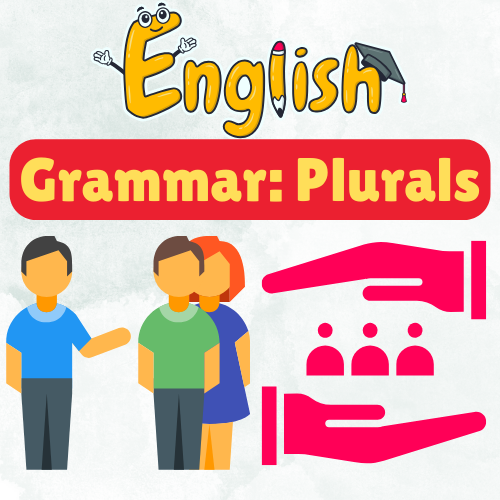

Introduction:
Welcome to our intermediate English lesson on plurals! Understanding how to form plurals is a fundamental aspect of English grammar. Plurals allow us to talk about more than one person, place, thing, or idea. In this lesson, you will learn about regular and irregular plurals, how they are formed, and their importance in effective communication. Let's dive into the rules and examples of plurals to enhance your English skills!
Lesson Content:
Introduction to Plurals:
Plurals are forms of nouns used to indicate that there is more than one of something. They are crucial in English grammar for accurate and clear communication. This lesson will help you understand how to change nouns from their singular to plural forms.
Regular Plurals:
Definition: Regular plurals are nouns that follow a consistent pattern when forming their plural forms, typically by adding "-s" or "-es."
Adding "-s": Most nouns form their plurals by adding "-s" to the singular form.
Examples:
cat → cats
book → books
car → cars
house → houses
dog → dogs
Adding "-es": Nouns ending in -s, -sh, -ch, -x, or -z typically form their plurals by adding "-es."
Examples:
box → boxes
bush → bushes
watch → watches
class → classes
buzz → buzzes
Irregular Plurals:
Definition: Irregular plurals are nouns that do not follow the typical rules for forming plurals. These nouns change in different ways.
Examples:
child → children
mouse → mice
tooth → teeth
man → men
woman → women
foot → feet
goose → geese
person → people
Usage of Plurals:
Using plurals correctly is essential for expressing quantity and ensuring grammatical accuracy. Here are some examples and contexts where plurals are used:
Examples of Regular Plurals:
"I have three cats."
"She read two books last week."
"We packed the boxes for moving."
"The bushes are blooming."
"They watched the birds in the trees."
"He has many cars in his collection."
"The houses on this street are beautiful."
Examples of Irregular Plurals:
"The children are playing in the park."
"I saw two mice in the kitchen."
"She has three teeth missing."
"The men are working on the roof."
"The women are preparing a meal."
"His feet are sore after the long walk."
"We saw a flock of geese flying south."
"Many people attended the event."
Introduction: Welcome to our intermediate English lesson on plurals! Understanding how to form plurals is a fundamental aspect of English grammar.
Plurals allow us to talk about more than one person, place, thing, or idea.
In this lesson, you will learn about regular and irregular plurals, how they are formed, and their importance in effective communication.
Let's dive into the rules and examples of plurals to enhance your English skills! Lesson Content: Introduction to Plurals: Plurals are forms of nouns used to indicate that there is more than one of something.
They are crucial in English grammar for accurate and clear communication.
This lesson will help you understand how to change nouns from their singular to plural forms.
Regular Plurals: Definition: Regular plurals are nouns that follow a consistent pattern when forming their plural forms, typically by adding "-s" or "-es." Adding "-s": Most nouns form their plurals by adding "-s" to the singular form.
Examples: cat → cats book → books car → cars house → houses dog → dogs Adding "-es": Nouns ending in -s, -sh, -ch, -x, or -z typically form their plurals by adding "-es." Examples: box → boxes bush → bushes watch → watches class → classes buzz → buzzes Irregular Plurals: Definition: Irregular plurals are nouns that do not follow the typical rules for forming plurals.
These nouns change in different ways.
Examples: child → children mouse → mice tooth → teeth man → men woman → women foot → feet goose → geese person → people Usage of Plurals: Using plurals correctly is essential for expressing quantity and ensuring grammatical accuracy.
Here are some examples and contexts where plurals are used: Examples of Regular Plurals: "I have three cats." "She read two books last week." "We packed the boxes for moving." "The bushes are blooming." "They watched the birds in the trees." "He has many cars in his collection." "The houses on this street are beautiful." Examples of Irregular Plurals: "The children are playing in the park." "I saw two mice in the kitchen." "She has three teeth missing." "The men are working on the roof." "The women are preparing a meal." "His feet are sore after the long walk." "We saw a flock of geese flying south." "Many people attended the event."
|
|

SingularSingular |

A cat is sleeping on the chair.A cat is sleeping on the chair. |

PluralPlural |

The cats are playing in the garden.The cats are playing in the garden. |

SingularSingular |

She has a book in her bag.She has a book in her bag. |

PluralPlural |

They have many books on the shelf.They have many books on the shelf. |

SingularSingular |

He has a box of chocolates.He has a box of chocolates. |

PluralPlural |

We bought two boxes of cookies.We bought two boxes of cookies. |

SingularSingular |

She has a bush in her garden.She has a bush in her garden. |

PluralPlural |

There are several bushes in the park.There are several bushes in the park. |

SingularSingular |

I have a child who loves to draw.I have a child who loves to draw. |

PluralPlural |

They are playing with their children in the park.They are playing with their children in the park. |

SingularSingular |

The mouse is hiding in the corner.The mouse is hiding in the corner. |

PluralPlural |

The mice are running around the house.The mice are running around the house. |

SingularSingular |

He has a toothache.He has a toothache. |

PluralPlural |

She lost her teeth in an accident.She lost her teeth in an accident. |
Great job! You have now learned the basics of regular and irregular plurals in English.
Practice forming plurals and using them in sentences to improve your grammar skills.
Mastering plurals will help you communicate more effectively and accurately.